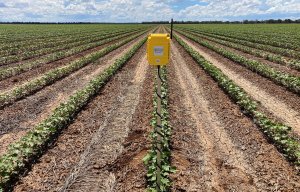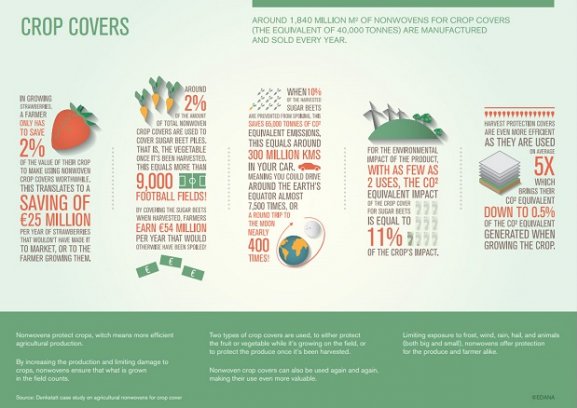
Optimising cotton crop yields with GoField
According to the European nonwovens organisation EDANA, nonwovens can make a big difference to the amount of food produced when growing crops and also in preventing spoilage once a crop has been harvested. For example, the Brussels based association says, when growing strawberries a farmer only has to save 2% of the value of their crop to make using nonwoven covers worthwhile. This, it says, could mean a saving of €25 million per year of strawberries that wouldn’t otherwise have made it to market. Around 1840 million square metres of nonwovens or crop covers, weighing about 40,000 tonnes, are manufactured each year, the organisation says.

25th April 2014
Innovation in Textiles
|
Brussels
According to the European nonwovens organisation EDANA, nonwovens can make a big difference to the amount of food produced when growing crops and also in preventing spoilage once a crop has been harvested. For example, the Brussels based association says, when growing strawberries a farmer only has to save 2% of the value of their crop to make using nonwoven covers worthwhile. This, it says, could mean a saving of €25 million per year of strawberries that wouldn’t otherwise have made it to market.
Around 1840 million square metres of nonwovens or crop covers, weighing about 40,000 tonnes, are manufactured each year, the organisation says.
Nonwoven crop covers can also be used again and again, and by increasing the production and limiting damage to agricultural crops, nonwovens ensure that what is grown in the field counts. Nonwovens are used effectively for optimising the productivity of crops, gardens and greenhouses. Their protective nature means that the need for pesticides is reduced and manual labour is kept to a minimum.
The use of nonwoven crop covers on the land increases yields and improves the quality of the crops. Very light, flexible sheets are laid over seed beds, which create a microclimate in which the heat and humidity are controlled. The growth of the plants is accelerated and they are protected from adverse weather conditions and vermin.
In capillary mat applications, nonwovens promote the healthy growth of flowers and vegetables in greenhouses by using soil-less growing methods.
Accordingly, EDANA has launched a series of infographics that show the benefits and impact of a life with nonwovens and one of the first to launch presents nonwovens used in coverings for agricultural crops. The images in the infographic below are drawn from a study of the role different types of nonwovens play in our lives, and their effect and impact, highlighting that nonwovens not only play a huge part in our lives, but in how we live them, says EDANA.
Pierre Conrath, Director of Sustainability and Public Affairs comments: “EDANA represents the full value nonwovens chain, from raw materials to converted products, and in our industry, we have seen sustainability mature to an ever greater awareness and understanding of the impact and value of products that we use in our lives every day.”
“By studying the impact nonwovens have in areas like crop coverings and road construction, we’re able to see a slice of life that hadn’t previously been studied, which has shown some amazing facts about the value of nonwovens,” added Conrath.
“Representing the nonwovens and related industries, we have many positive examples to share about our member’s businesses and products,” said Abby Bailey, Director of Marketing and Communications “and these infographics are a new way in which we can help get the story out, and explain the way in which their products help to make our life not only better, but more sustainable”

Business intelligence for the fibre, textiles and apparel industries: technologies, innovations, markets, investments, trade policy, sourcing, strategy...
Find out more